|
Large Powerful shoulders project a powerful
physique. Broad shoulders are what make a person look powerful, the shoulders
are also one of the first noticed and admired bodyparts. With the exercise
routines explained below, lets try to make yours as large and as powerful as
humanly possible.
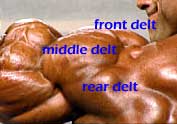 Delt
- deltoids - or shoulders - are a three headed muscle.
The basic function is to lift the arm in from any direction, and to
rotate the arm as well. The front or anterior delt lifts the arm to
the front, medial or middle to the side and posterior or rear to the
rear. Note: the trapezius comes strongly into play after the arm has
been raised above shoulder level. Delt
- deltoids - or shoulders - are a three headed muscle.
The basic function is to lift the arm in from any direction, and to
rotate the arm as well. The front or anterior delt lifts the arm to
the front, medial or middle to the side and posterior or rear to the
rear. Note: the trapezius comes strongly into play after the arm has
been raised above shoulder level. |
 The overhead press, whether it be performed behind the neck or in front, it
probably the most basic and also the most effective exercise for the DELTOIDS. There are 3 heads to the Deltoid muscle, the
front and behind the neck presses work the front delts and the top part of the
rear delts. The main advantage to these type of presses is that they add
roundness to the deltoids. I will first explain the front press. This exercise
is performed by pressing the weight upward until the arms are fully extended and
lowering the weight down until barely resting on the collar bone. You should use
a moderate weight so at least 3 to 4 sets of 8 to 10 reps can be achieved.
Needless to say, form is extremely critical in this exercise. If this exercise
is new to you, you may find yourself needing a spotter until the correct form is
achieved. It is important to have a smooth controlled motion when peforming this
exercise. These should be done with a wide grip on the bar so the entire muscle
group can be worked. The same holds true for the behind the neck press which is
done in the same manner but the starting is with the bar resting behind the neck
and on the traps. Be careful not to overload the delts when doing the behind the
neck press because the rotator cuffs can easily be damaged. The key to having
massive delts is to think big and train heavy-- but also train safe. Always
focus on trying to increase the weight that you're lifting. Never be satified
with staying with the lighter weight.
The overhead press, whether it be performed behind the neck or in front, it
probably the most basic and also the most effective exercise for the DELTOIDS. There are 3 heads to the Deltoid muscle, the
front and behind the neck presses work the front delts and the top part of the
rear delts. The main advantage to these type of presses is that they add
roundness to the deltoids. I will first explain the front press. This exercise
is performed by pressing the weight upward until the arms are fully extended and
lowering the weight down until barely resting on the collar bone. You should use
a moderate weight so at least 3 to 4 sets of 8 to 10 reps can be achieved.
Needless to say, form is extremely critical in this exercise. If this exercise
is new to you, you may find yourself needing a spotter until the correct form is
achieved. It is important to have a smooth controlled motion when peforming this
exercise. These should be done with a wide grip on the bar so the entire muscle
group can be worked. The same holds true for the behind the neck press which is
done in the same manner but the starting is with the bar resting behind the neck
and on the traps. Be careful not to overload the delts when doing the behind the
neck press because the rotator cuffs can easily be damaged. The key to having
massive delts is to think big and train heavy-- but also train safe. Always
focus on trying to increase the weight that you're lifting. Never be satified
with staying with the lighter weight.
|
 The
shoulder shrug is also an excellent exercise for building mass in the
shoulders.
Most people use this exercise to build mass in the trap area but the deltoids
are also worked with this exercise. This exercise should be done with EXTREMELY
heavy weights. It is performed by holding the weights (one in each arm) waist
side and shrugging the shoulders. The shoulders should be rolled in a circular
motion until total exhaustion is achieved. It is beneficial if the shoulder
muscles are flexed at the top of the rep. It is also necessary to perfom these
slowly and controlled and try to get the most out of each rep. When I do shrugs,
I tend to put them towards the end of my routine and use them as a final burn
exercise, therefore I really don't count the amount of sets that I do. I do them
until total exhaustion occurs. I found these to work better for me toward the
end of my routine which allows me to use the presses and lateral raises as my
main mass exercises. Different routines work for different people, the best
thing to do is to see whats works best for you, whatever it may be, definetly
include shrugs into your routine. No shoulder routine is complete without them. The
shoulder shrug is also an excellent exercise for building mass in the
shoulders.
Most people use this exercise to build mass in the trap area but the deltoids
are also worked with this exercise. This exercise should be done with EXTREMELY
heavy weights. It is performed by holding the weights (one in each arm) waist
side and shrugging the shoulders. The shoulders should be rolled in a circular
motion until total exhaustion is achieved. It is beneficial if the shoulder
muscles are flexed at the top of the rep. It is also necessary to perfom these
slowly and controlled and try to get the most out of each rep. When I do shrugs,
I tend to put them towards the end of my routine and use them as a final burn
exercise, therefore I really don't count the amount of sets that I do. I do them
until total exhaustion occurs. I found these to work better for me toward the
end of my routine which allows me to use the presses and lateral raises as my
main mass exercises. Different routines work for different people, the best
thing to do is to see whats works best for you, whatever it may be, definetly
include shrugs into your routine. No shoulder routine is complete without them.
|
|
The
basic
Lateral exercise is mainly used to target the middle and side
delts. Another
variation of the Lateral is the bent over Laterals which target the deltoid more
directly than the behind the neck press because it focuses more on the area
where the deltoid meets the back. The basic side Lateral is performed (standing
or sitting) with the dumbells at the waist side. The weights should be brought
up sideways until each dumbell is parallel to the shoulders. You can bring each
weight up separately or simultaneously. I prefer simutaneously with the basic
laterals because my formed is less compromised. The bent-over lateral shall be
performed in the same manner but the difference is that you should lean foward
until the upper body is at a 45 degree bend. You must do this type
simultaneously. The amount of weight that should be used should be appropriate
so that at least 4 sets of 8 to 10 reps can be achieved. Adjust weight
accordingly until this is achieved. When doing laterals, don't focus on just
trying to swing the weight up, Take a one or two second pause in the air with
the weight at the top position so you can isolate and contract the muscle.
Remember to try to constantly increase the dumbell weights over periods of time
to allow your body to continue to be stressed. This is the only way to promote
growth.
|
|
 The basic
dip exercise it always overlooked by bodybuilders as being a major exercise for
the shoulder development. Most builders use the dip exercise to target the chest
area only. Dips work just as well for developing the delts. Dips are performed
with a basic dip machine, ensure you slowly lower yourself down as much as
possible and try not to swing, pause for a second, then finish the rep by
raising yourself until the arms are almost locked. An enhancement to this
exercise is to strap on a weight belt and add weights to the belt. This is great
for people with enormous upper body strength who can do several sets of dips
without feeling any type of stress. I often do several sets of dips with my body
weight only so I can achieve an enormous amount of reps. With a strict
technique, You can still get in a shoulder good workout even If you do less than
the maximum weights. Another word of caution pertaining to the rotator cuffs,
when using the weight belt, be careful not to go too heavy because the cuffs are
easily damaged when doing these. Be sure you're doing each rep in a smooth and
controlled motion. Any type of damage to the shoulder will hinder the training
of nearly every other upper body part.
The basic
dip exercise it always overlooked by bodybuilders as being a major exercise for
the shoulder development. Most builders use the dip exercise to target the chest
area only. Dips work just as well for developing the delts. Dips are performed
with a basic dip machine, ensure you slowly lower yourself down as much as
possible and try not to swing, pause for a second, then finish the rep by
raising yourself until the arms are almost locked. An enhancement to this
exercise is to strap on a weight belt and add weights to the belt. This is great
for people with enormous upper body strength who can do several sets of dips
without feeling any type of stress. I often do several sets of dips with my body
weight only so I can achieve an enormous amount of reps. With a strict
technique, You can still get in a shoulder good workout even If you do less than
the maximum weights. Another word of caution pertaining to the rotator cuffs,
when using the weight belt, be careful not to go too heavy because the cuffs are
easily damaged when doing these. Be sure you're doing each rep in a smooth and
controlled motion. Any type of damage to the shoulder will hinder the training
of nearly every other upper body part.
One thing to remember when training the deltoids is that you indirectly
hit different heads of the delts when training other bodyparts such as chest and
back. So if a particular head is getting alot of indirect work, you may not need
to do as much direct work for it as the other two heads.
|
 |
Sweat Those Shoulders!
Each set consists of eight
repetitions. To warm up: Do a set at fifty percent of your maximum
effort. Begin with three sets of eight. When you can't break a sweat
with that, add five more reps to each set.
Military
press. Stand or sit on an exercise bench. Grasp a barbell
with your hands slightly wider than shoulder-width apart. Raise it
above your head, then lower it until it touches the back of your
shoulders. |
 |
Seated
lateral raise. Sit on the end of an exercise bench with
your legs and feet together. Hold a dumbbell in each hand and, with
your palms facing you, lift your arms straight out to your sides.
Like a bird. A big bird. A strange bird. |
 |
Seated
bent-over dumbbell raise. Sit on the end of a bench with
your legs together. With your torso bent and your chest touching
your knees, raise the dumbbells out to your sides until your upper
arms are parallel to the floor The dumbbells should be in line with
your ears. |
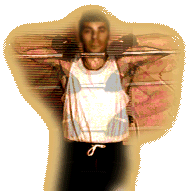 |
Upright
row. Standing, grasp a dumbbell with your hands eight
inches apart, palms facing your body. Raise the bar until it's just
under your chin, and your elbows are in line with your ears. Keep
your back straight at all times. No jolting.
The one to do if you're doing only
one? Military press.
|
| |
Military Press
From a standing position, start with
the bar as pictured in the first photo. Lower the bar to the upper portion
of your chest, press upward concentrating on using only the shoulder
muscles. Be careful not to lean back to far as you do this movement. This
exercise can also be done from a seated position to avoid injuring your
back.
* Muscle Confusion Tips. Alternate lowering the bar to the front one
workout and to the back on the next. There should be several different
machine variations of this movement in your gym. |


|
Dumbell Press
From a seated position start as
pictured in the first photo. Press upward and move the dumbbells inward as
pictured in the second photo. This movement seems very similar to the
military press, however by moving the dumbbells inward as you press upward
you dramatically change the movement.
* Muscle Confusion Tips: Alternate your starting hand position by
turning your palms inward instead of outward as you begin the movement. As
you press upward rotate your wrist outward and move the dumbbells inward.
You may find it more comfortable to start with the dumbbells closer
together when starting with your palms facing inward. |
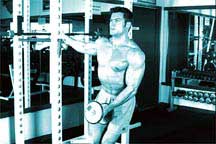

|
One Arm Side Laterals
Start from a standing position and hold
onto something very stable as shown in the photo. Elevate the dumbbells up
with your wrist slight bent as if you are pouring water. Do not go above
parallel or you may injure your shoulder.
* Muscle Confusion Tips: In this photo TJ’s legs are
together, you may
try a shoulder width stance with a slight forward lean -- you should be
able to use heavier weights when doing them this way. You can also do both
arms at once from a seated position with as light forward
lean. |
 |
Bent Over Rear Delts
This is probably the best way to
concentrate on the rear delts. The photos best describe the proper
movement for this exercise. Notice that T.J.'
|
|
Take a
Look at Those Delts...
Kenneth Etta, winner of the Max Muscle Naturals, has a surprising shoulder
routine which intermediate and advanced bodybuilders may want to examine
closely. Its construction seems to run counter to some advice and current
trends, but could serve as an excellent intermediate's primary routine, or
as a changeup and confusion workout for the advanced practitioner.
Sets
& Reps
Etta varies his routine a lot, and his sets and reps vary widely as
well. He often uses a pyramiding routine, upping the weight with each set
to create a 30/25/15/10/5 rep scheme. It's very rare that we see a routine
with such a high first and second set rep goal, most running down from 15
down to 8 or so. "Most of my exercises start light and progress to as
heavy as I can, and the reps, of course, decrease with the poundage,"
says Etta. "This works for me. Occasionally, I will keep the reps the
same from lightest weight to the heaviest, but still limiting the reps to
about 10 per set. Or I'll do sets of 10 at various weights until I'm
thoroughly fatigued and can't do any more whatsoever." At the heart
of this, then, is muscular confusion, keeping the routine fresh so the
body can't adapt to the loads. Etta's basic training movements don't
change, but he adds a lot of different minor exercises for finishing off
the routine, For example, he'll substitute hammer front raises, which he
saw Flex perform at a gym, for the more frequently seen front raises.
Underlying
It All:
"I attempt to do the heaviest weight I can without sacrificing form.
Once I feel my form is getting out of balance I don't go beyond that. If I
can't sustain a rep goal at a heavier weight without sacrificing form, I
just do more reps.
|
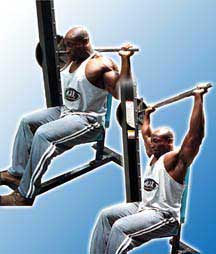 |
Seated Behind-the-Neck Presses on Smith
Machine:
Behind-the-neck presses have fallen out of favor with many bodybuilders.
Master Moves columnist and Mr. Olympia Masters Champion Jim Morris
suggests both he and Joe Gold believe that the behind-the-neck presses
cause a high percentage of gym-related neck injuries. But the 5'9Ó Etta
and many topline pros consider this front and side deltoid mass-builder
the mainstay of a shoulder routine. Etta begins his routine with this
exercise because of this. He'll warm up with just the bar or 2 25-pound
weights, and increase the weight with 25's until he has 3 "quarters"
on each end. Note that he pushes the bar almost until his elbows lock out
(but not quite...he doesn't want to relieve tension on the muscle group).
Etta also brings the bar down considerably lower than some experts suggest,
allowing it to almost rest on the nape of his neck. Most experts, however,
suggest letting it come down no lower than the bottom of the ear. If
you're performing the more commonly seen presses which come in front of
the body, the weight is often taken much lower, coming to rest on the
chest plate (upper pec).
You'll find 3 pieces of preparation
help enormously:
-
Wear a
lifting belt. When pressing heavy weight over head, the back is
subjected to enormous compressing forces.
-
Warm up
with at least 2 sets done at 20 to 30% of the weight you estimate will
be used at a 10-rep-to-muscular-failure level.
-
At the
lowered beginning position the forearms should be perpendicular - 90
degrees - to the ground; this also means they are "straight up."
If your hands are positioned too close to each other, creating an
angled forearm position, the triceps become more involved. (The
triceps are integrally involved in any pressing motion, whether you're
lying, seated, or standing, but the intention in working the shoulders
is to minimize that involvement and isolate the shoulders as much as
possible).
|
 |
Front Dumbell
Raises:
Etta begins with 2 light warm-up sets and then pyramids up for this front
deltoid exercise, increasing weight with each successive set. This means
he'll perform fewer repetitions in each successive set, as his muscles
fail comparatively earlier (due to this increasing weight). Note that Etta
does this movement a little differently than you may see in the gym. He
does not alternate arms, and he brings the dumbbells to just a few inches
above eye level. Most bodybuilders alternate arms and bring the weights
well above their head. But Etta believes that the average bodybuilder is
more prone to cheat the movement by alternating arms; by keeping the
weights no higher than the top of his head, he also minimizes the
possibility of lower back strain (especially important when doing the
raising the dumbbells simultaneously). |
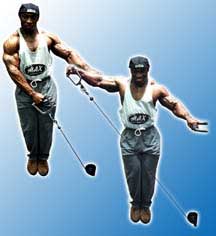 |
One-Arm Cross
Cable Lateral Raises:
Although this exercise affects all 3 heads of the deltoid, its primary
emphasis is on the middle head. You can keep your unused hand on your hip
or steady yourself by placing that hand lightly against a support. These
lateral raises demand attention to detail in order to be effective, so
make sure to keep these tips in mind: 1) Use your deltoids to raise the
weight in a smooth, flowing motion. Do not dip your knees or twist your
torso to accomplish the raising motion; keep the tension and emphasis on
the shoulder work. 2) As the weight passes your pecs, begin to twist the
top of your hand slightly down and forward, as if you were pouring water
from within the circle created by your thumb and forefinger. 3) Raise the
handle as high as the top of your head and then slowly lower the weight.
4) For a nice changeup, try beginning the exercise with your arm behind
your back to begin the movement. |
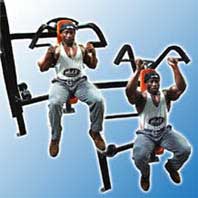 |
Palms-In
Machine Presses:
Emphasizing the front and middle deltoids, the palms-in machine press
allows you to do a very strict movement, which Kenneth Etta uses to finish
off his routine and thoroughly flush his delts. Since this is the last of
his shoulder exercises, he uses a relatively low weight, partially because
he wants relatively higher reps to thoroughly flush and pump the area, and
partially because his deltoids have been pushed to exhaustion repeatedly
and his ability to lift large amounts of weight at this point in the
routine is limited. |
|
[ Tips for beginners ] [ guns ] [ tri ] [ chest ] [ back ] [ delts shoulders ] [ abs ] [ quads hams ] [ tips ] [ tips - next ] [ composition des aliments ]
| |
|
 Delt
- deltoids - or shoulders - are a three headed muscle.
The basic function is to lift the arm in from any direction, and to
rotate the arm as well. The front or anterior delt lifts the arm to
the front, medial or middle to the side and posterior or rear to the
rear. Note: the trapezius comes strongly into play after the arm has
been raised above shoulder level.
Delt
- deltoids - or shoulders - are a three headed muscle.
The basic function is to lift the arm in from any direction, and to
rotate the arm as well. The front or anterior delt lifts the arm to
the front, medial or middle to the side and posterior or rear to the
rear. Note: the trapezius comes strongly into play after the arm has
been raised above shoulder level. The
The  The
The
 The
The












